Nursery rates relief: evaluation
Evaluation of the nursery non-domestic rates relief scheme implemented in Scotland during 2018. We committed to evaluating the benefits of the scheme after it had operated for three years.
2. Childcare sector - trends, policy context and economic outlook
2.1 The expansion of Funded Early Learning and Childcare
In 2014, the Scottish Government set out a commitment to increase the number of funded ELC hours from 600 hours per year for eligible children to 1140 hours per year by 2020. Local authorities are responsible for making funded ELC available to all eligible children in their area. This can be through local authority settings or by contracting with providers in the private, third and childminding sectors.
Investment in increasing the capacity (in terms of both workforce and infrastructure) required for the expansion in funded hours began in 2017-18. A statutory duty was placed on education authorities to make 1140 hours of ELC available to all eligible children from 1 August 2020. The COVID-19 pandemic led to a delay in the statutory roll out of 1,140 hours, with the statutory duty coming into effect from 1 August 2021.
The expansion of funded ELC hours is intended to improve outcomes for children, including by reducing the poverty-related attainment gap in schools. It is also intended to contribute to important outcomes for parents and families. The aims of the expansion can be summarised in the three high level outcomes below:
- children's development improves and the poverty related attainment gap narrows
- parents' opportunities to take up work, study or training increase
- family wellbeing improves
NRR may also contribute to the above outcomes, by improving the financial sustainability of providers in the sector. Possible impacts of the NRR are discussed in more detail in Section 3.
2.2 The childcare sector in Scotland – overview
As of April 2022, there were a total of 3,522 day care of children settings registered with the care inspectorate, with a total registered capacity of around 178,500 children. Of these, 1,781 were local authority run settings, 1,021 were private, 717 were voluntary or not for profit (third sector) and 3 were health board settings[5]. All of these categories of settings would be likely to be required to pay non-domestic rates, although some may be eligible for some other kind of relief (for example Charitable relief). However, childcare settings will only be eligible for NRR if they operate out of a building which 'wholly or mainly' operates as a nursery. This means that settings within buildings mainly used for other purposes (e.g. churches, schools, etc.) will not be eligible for the relief if the property is not wholly or mainly used as a day nursery.
In addition to day care of children settings, there were 3,796 childminders registered with the Care Inspectorate in April 2022 with a total registered capacity of around 23,400 children or around 11.6% of total capacity of the sector. Note that while some settings that have been identified as providing School Age Childcare as a primary service have not been included, in both the case of day care of children and childminder settings, some capacity may be used for care of school age children and it is not possible to identify those settings providing funded ELC in the Care Inspectorate's most recent dataset as it is currently published. As childminders provide childcare from their own homes, they are not typically rated or liable for Non-Domestic Rates[6], and so are not likely to benefit from Nursery Rates Relief.
The Care Inspectorate does publish more detailed statistics on the childcare sector that allow for different types of childcare settings to be more clearly distinguished, the most recently published dataset being as at December 2020. These show that the total number of childminders and day care of children services registered with the Care Inspectorate fell from 9,859 in 2014 to 7,983 in 2020. This fall, however, was due to a reduction in the number of childminders and day care of children services other than nurseries. The number of nurseries actually increased from 2,443 in December 2014 to 2,516 in 2020[7].
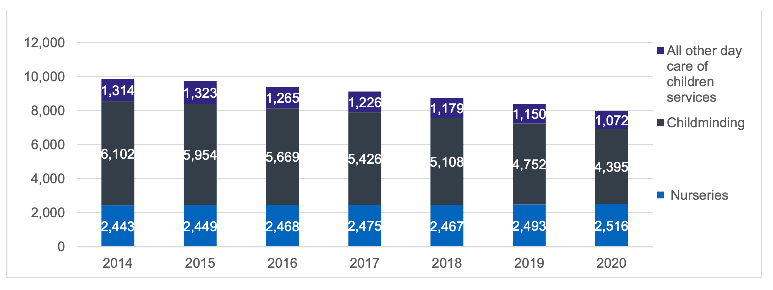
While the total number of childcare services decreased between 2014 and 2020, the total capacity of the sector increased from around 191,880 registered places to around 203,570 in the same period. Within this total, nurseries increased their capacity (from 108,210 to 129,620) while also increasing their share of total capacity from 56% to 64% of total capacity across the childcare sector in December 2020. The increase in the number of nurseries and their share of capacity in the childcare sector began prior to the introduction of NRR.

Figures from the ELC census show that as at September 2021, there were 91,603 children registered for funded ELC in 2,630 settings, of which, 1,627 were local authority settings and 1,003 were private or third sector settings with 30.5% of children registered for funded childcare with funded providers in the private and third sector[8]. These figures do not include childminders providing funded ELC.
The total number of registrations in childcare settings for children under 6 years old was around 165,030 as at December 2020. This was considerably lower than in December 2019 when there were around 207,680 registrations for children under 6 years old. While the total number of registrations did decrease each year from December 2017 to December 2020, the number of registrations as a percentage of the population of under 6s remained largely similar between 2017 and 2019 with a larger fall in 2020[9], possibly reflecting the impact of the Covid-19 pandemic on the childcare sector outlined in section 1.1.
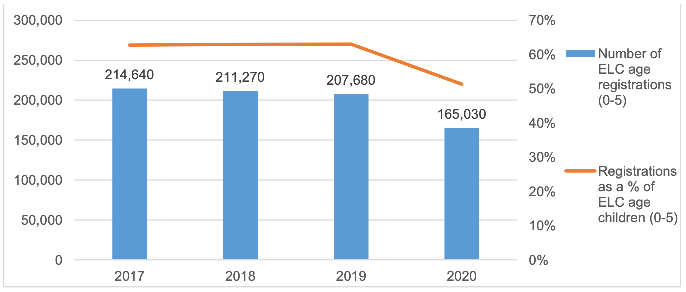
Scottish Government Early Learning and Childcare statistics indicate that registrations of three and four year olds have fallen since 2017. In September 2017, there were 84,872 registrations of three and four year olds for funded childcare places, falling to 78,115 by 2021.
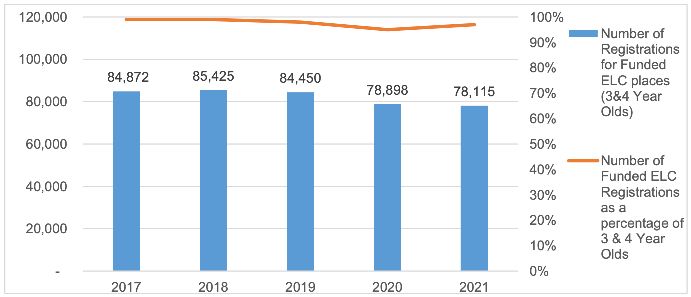
Grading of Care Inspectorate reports on nurseries imply a high level of quality in the sector overall with 90.2% of all nurseries that were graded receiving all grades "good" or better. The proportion of nurseries receiving "good" or better grades was higher amongst local authority nursery settings (94.1%) and lower amongst private nursery settings (82.3%)[10].
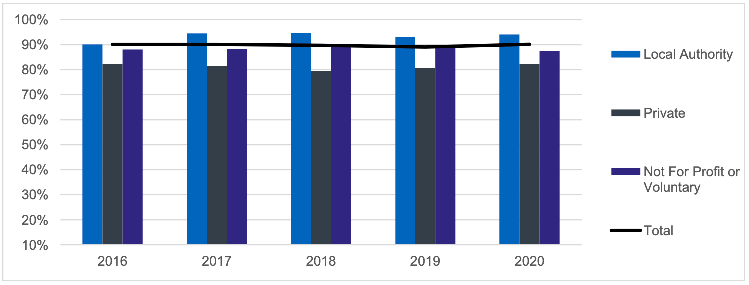
The average proportion of nurseries receiving all grades on their inspection reports either good or better has remained at broadly the same level in the 5 years from 2016 to 2020 with local authority nurseries being the most likely to receive all grades good or better and private nurseries the least likely over all 5 years.
2.3 The Financial Sustainability Health Check and the economic outlook
In April 2021, the Scottish Government began work on the Financial Sustainability Health Check (the Health Check) to assess the sustainability of the sector, in particular the impact of the COVID-19 pandemic on the childcare sector and of the financial support made available in response to it. The Health Check involved:
- detailed surveys of childcare providers, with separate surveys for day care of children and childminding services
- in-depth case study interviews with a range of providers
- in-depth one-to-one discussions with each the provider representative bodies (Care and Learning Alliance (CALA), Early Years Scotland (EYS), National Day Nurseries Association (NDNA), Scottish Childminding Association (SCMA), and the Scottish Out of School Care Network (SOSCN)
- analysis of trends in Care Inspectorate registration data
The survey results of providers' own assessments of their sustainability indicated a reduction in the proportion who reported their financial position to be sustainable, from 79% in March 2020 to 46% in May 2021. The proportion of providers with serious concerns about the sustainability of their business increased from 11% in March 2020 to 28% in May 2021. Of those services providing funded ELC, 50% indicated confidence in their sustainability in May 2021 whereas 44% of services not providing funded ELC indicated confidence in their sustainability. Similarly, 20% of services providing funded ELC expressed serious concerns about their sustainability compared to 31% of those that did not provide funded ELC[11].
The Health Check reported a significant fall in the occupancy rates of childcare settings between March 2020 and May 2021[12] with around a four-fold increase of services that provided funded childcare reporting occupancy levels of 50% or less in May 2021 compared to March 2020. For childcare services that did not provide funded places, 56% reported occupancy levels of 50% or less in May 2021 compared with 11% reporting that their occupancy levels were 50% or less in March 2020. This is likely due to a reduction in demand for formal childcare due to the wider labour market impacts associated with the pandemic such as furlough, and an increase in home working.
While the responses to the Health Check survey indicated increased concern about sustainability amongst providers, there was no increase in the number of childcare settings cancelling their Care Inspectorate registration in 2020 or 2021 when compared to 2019. The overall trend in the number of cancellations amongst day care of children settings between 2014 and 2021 was downward, although it peaked in 2016. The number of day care of children settings cancelling their registration was lower in 2021 than every other year in the period, as was the rate of cancellations as a percentage of the total number of services registered.
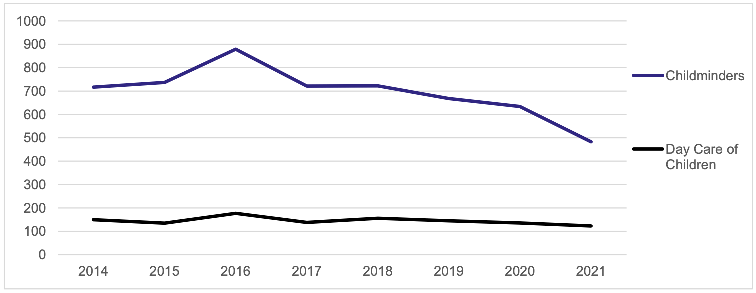
The costs of delivering an hour of ELC for 3 to 5 year olds is estimated by the survey participants to have increased by around 10% between March 2020 and May 2021 for private settings[13]. Many of the reasons cited for the cost increases were related the COVID-19 pandemic, for example: increased cleaning requirements, the need for PPE and additional staff costs associated with COVID-19. In addition, the cost of utilities and of meeting Real Living Wage requirements was also cited.
Data collected by the Health Check indicates that some of these costs were passed on to parents, with the mean fee for providing childcare to 3 to 5 year olds in private services rising by around 4% to £5.52 per hour between March 2020 and May 2021. A rate of £5.52 per hour also represents an increase in real terms of around 8.7% when compared to the average hourly rate for childcare of 3 and 4 year olds amongst private settings indicated by Scottish Government research in 2016[14]. This comparison is intended to be illustrative only as the figures are taken from two separate pieces of research that used different methodologies.
Although the focus of the Health Check and many of the concerns regarding cost and financial sustainability for the childcare sector were impacts arising from the Covid-19 pandemic, the overall economic outlook remains challenging. The OBR forecasts a fall of 2.2% in real household disposable income in 2022-23, an unprecedented fall for a single year in ONS records[15]. Similarly, the Scottish Fiscal Commission forecasts a fall in real average earnings for Scotland of 2.7% in 2022-23[16].
The impact of a fall in real earnings and disposable income on the childcare sector is unclear as it is dependent on the net effects of a number of possible responses from households such as the way that a fall in earnings may interact with income or employment related benefits to influence the labour market behaviour of families. For example, an increase in the cost of childcare relative to the household budget may result in some households reducing their demand for formal childcare by increasing their reliance on informal childcare or reducing the number of hours they work.
Alternatively, households may respond to a reduction in real household income by increasing the number of hours they work, where this is possible, and therefore increasing demand for childcare. This response may be especially prevalent in those households whose children are currently utilising less than their full 1140 hours of funded childcare, as the net increase in income from any additional hours worked will only be reduced by childcare they may have to purchase over and above their funded childcare entitlement. The potential for an increase in the demand for childcare due to an increase in the number of hours worked may be limited, however, by the number of households with multiple children, not all of whom will necessarily be entitled to funded childcare. In addition, those households able to access funded childcare for all of their children may be more likely to be working full time and therefore they may have little scope to significantly increase the number of hours they work.
Contact
Email: ELCPartnershipForum@gov.scot
There is a problem
Thanks for your feedback